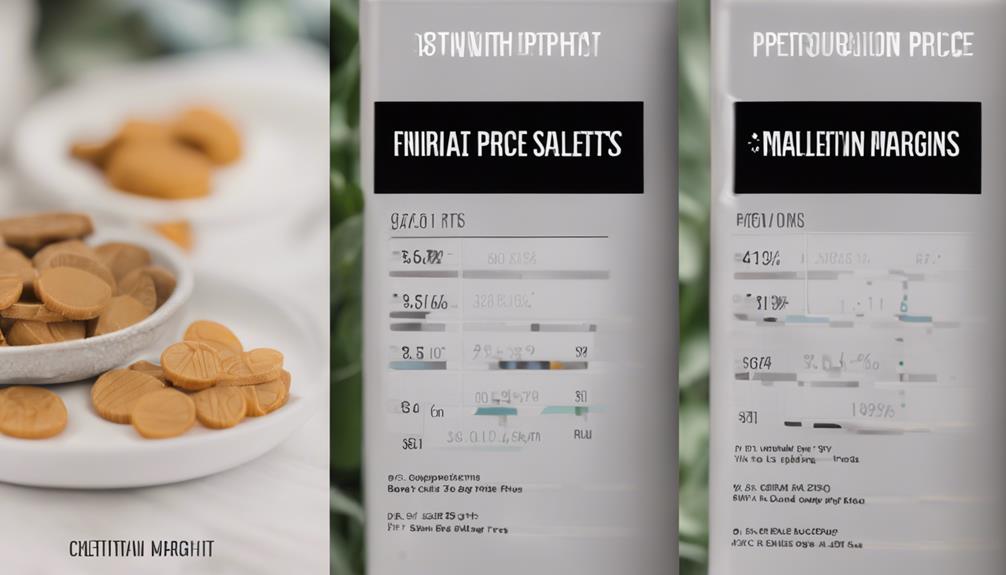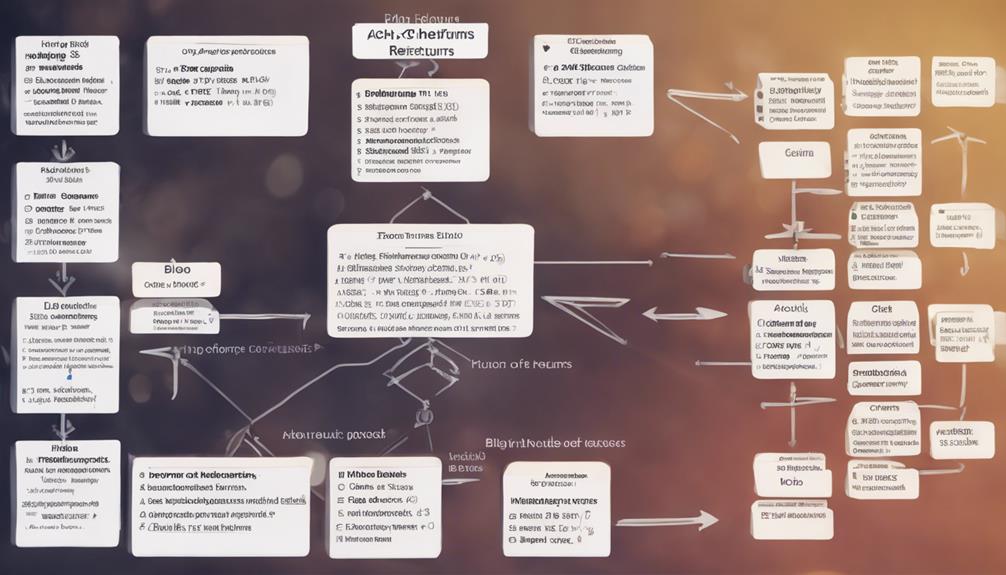Understanding markup and margin is key for pricing. Markup is added to cost for the selling price, while margin is revenue minus costs. Analyze margin for financial health insights. Review pricing to boost margins. Use this knowledge for better pricing decisions. Look into Contribution Margin Analysis for profitable products. Break-Even Analysis helps with sales targets. Maximizing profit means controlling costs and efficiency. Pricing strategies impact profitability and competitiveness. Choose payment processors wisely. Focus on cost control, pricing, and operations to enhance profit margin. For a deeper understanding of profitability secrets, explore the nuances of markup, margin, and strategic pricing strategies.
Key Takeaways
- Understand markup and margin for pricing decisions.
- Analyze profit margin for financial health.
- Utilize contribution margin analysis.
- Implement strategic pricing strategies.
- Optimize profit margin through cost control.
Importance of Markup and Margin

Understanding the critical importance of markup and margin is essential for making informed pricing decisions in your business. Markup is the percentage added to the production cost to determine the selling price, while margin is the revenue minus the cost of goods sold (COGS).
By differentiating between profit margin and markup, you can grasp a clearer picture of your business's financial health. Analyzing profit margins can reveal your company's stability and operational efficiency. It can also help you identify areas for improvement and potential cost savings. On the other hand, understanding markup can help you determine the appropriate pricing strategy for your products or services. By mastering merchant service provider rates and fees, you can further optimize your business’s financial performance and competitiveness.
By reviewing your cost structure and pricing strategies, you can work towards improving your margins and overall profitability. Remember that markup helps set the minimum selling price but doesn't consider external factors like competition or demand.
Utilize your understanding of markup and margin to optimize pricing decisions and enhance your business's bottom line.
Profitability Analysis Techniques

To analyze profitability effectively, implement advanced techniques for evaluating your business's financial performance. One way to do this is by conducting a profitability analysis using various methods. Below is a table that showcases different profitability analysis techniques:
| Profitability Analysis Techniques | Description | Benefits |
|---|---|---|
| Contribution Margin Analysis | Evaluates each product's | Helps in identifying |
| contribution to covering | the most profitable products | |
| fixed costs and generating | and optimizing product mix | |
| profit | ||
| Break-Even Analysis | Determines the point at | Helps in setting sales |
| which revenue equals costs | targets and pricing strategies | |
| to break even | ||
| Return on Investment (ROI) | Measures the return on | Assists in evaluating |
| investment relative to its | the profitability of | |
| cost | different investment options |
These techniques can provide valuable insights into your business's profitability and help in making informed financial decisions.
Strategic Pricing Strategies

For effective business growth, implementing strategic pricing strategies is essential in maximizing profitability and gaining a competitive edge in the market. By strategically setting prices, you can attract customers, increase sales, and improve overall revenue.
Consider factors like production costs, competitor pricing, and customer value perception when determining your pricing strategy. Offering discounts, bundling products, or implementing dynamic pricing based on demand can help you optimize profits.
Regularly review and adjust your pricing strategy to stay competitive and adapt to market changes. Remember, pricing is a powerful tool that can have a profound impact on your business's success, so invest time and effort in developing a pricing strategy that aligns with your business goals and target market.
Impact of Payment Processors

When choosing a payment processor, consider the impact on your business's financial efficiency and customer experience. The selection of a payment processor can greatly influence your profitability and operations.
Factors such as processing fees, integration options, security features, customer support, and payment processing speed should all be taken into consideration. High processing fees can cut into your margins, while slow processing speeds can result in a poor customer experience. Seamless integration and robust security features can boost customer trust and satisfaction.
Maximizing Profit Margin

Consider strategies to optimize your profit margin for enhanced financial performance and sustainability. To maximize profit margin, focus on cost control, pricing strategies, and operational efficiency.
Analyze your cost structure to identify areas where expenses can be reduced without compromising quality. Implement competitive pricing that reflects the value of your products or services while remaining attractive to customers.
Streamline operations to improve productivity and minimize waste. Regularly review your profit margin to track performance and make adjustments as needed. By prioritizing profit margin optimization, you can strengthen your financial position, boost profitability, and secure long-term success.
Frequently Asked Questions
How Can I Calculate the Optimal Markup Percentage for My Products?
To calculate the best markup percentage for your products, consider your production costs and desired profit margin. Determine the selling price by adding the markup percentage to the cost price.
Analyze market trends, competition, and customer demand to set competitive prices. Regularly review and adjust your pricing strategy to guarantee profitability.
Track sales performance and customer feedback to fine-tune your pricing approach for maximum success.
What Are the Key Differences Between Gross Margin and Net Margin?
What sets apart gross margin from net margin?
Gross margin is the percentage of revenue after deducting the cost of goods sold. On the other hand, net margin is the percentage of revenue remaining after subtracting all expenses, including operating costs and taxes.
While gross margin focuses on production efficiency, net margin provides a thorough view of overall financial health.
Understanding these distinctions is essential for evaluating profitability accurately and making informed business decisions.
How Do Payment Processor Fees Affect Overall Profit Margins?
Payment processor fees directly impact your profit margins by reducing the revenue you retain from each transaction. These fees, typically a percentage of each sale or a flat rate, can eat into your profits.
To mitigate their impact, consider negotiating lower rates, optimizing your pricing strategy, or choosing a payment processor with competitive fees. Monitoring and managing these costs are essential for maximizing profitability in your business operations.
Is It Better to Focus on Increasing Sales Volume or Profit Margin?
When deciding between increasing sales volume or profit margins, consider your business goals. Boosting sales volume can lead to more revenue but may strain resources.
Focusing on profit margins can enhance efficiency and sustainability. Find a balance that aligns with your objectives.
Analyze market trends, competition, and customer behavior to make informed decisions. Prioritize long-term profitability while keeping customer satisfaction in mind.
Tailor strategies to fit your business model for best results.
Can Pricing Software Help in Determining the Optimal Markup Strategy?
Using pricing software can indeed assist in determining the best markup strategy. By analyzing market trends, competitor pricing, and cost structures, such tools help you make informed decisions.
They enable you to set competitive prices while ensuring profitability. With real-time data and insights, pricing software streamlines the process, allowing you to adjust pricing strategies efficiently.
Embrace this technology to fine-tune your markup strategy and enhance overall profitability.
Conclusion
To sum up, grasping the difference between markup and margin is essential for maximizing profitability in your business.
Did you know that on average, companies with higher profit margins tend to have a stronger financial foundation and are better equipped to weather economic downturns?
By mastering these concepts, you can make informed pricing decisions that lead to long-term success and growth.
Start unraveling the secrets of profitability today.










